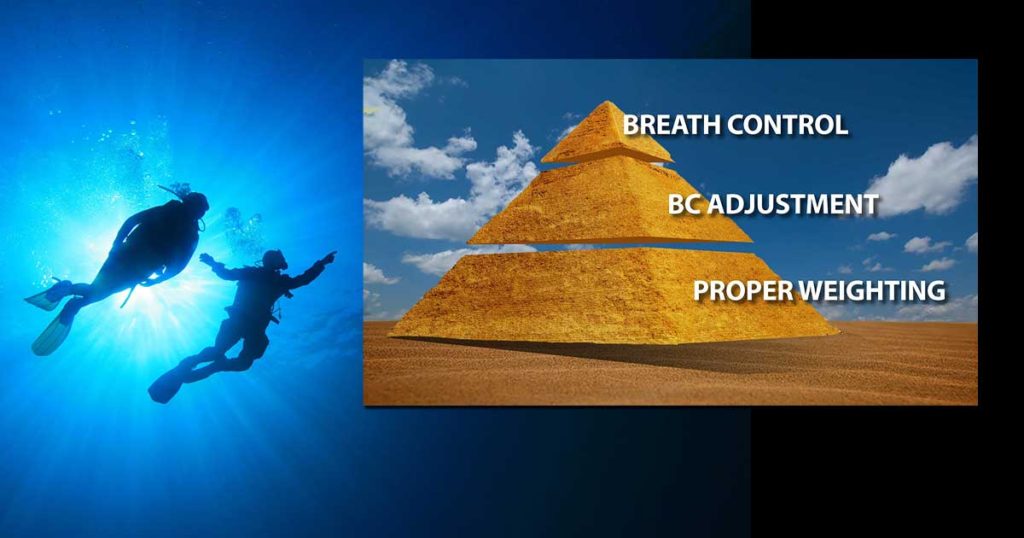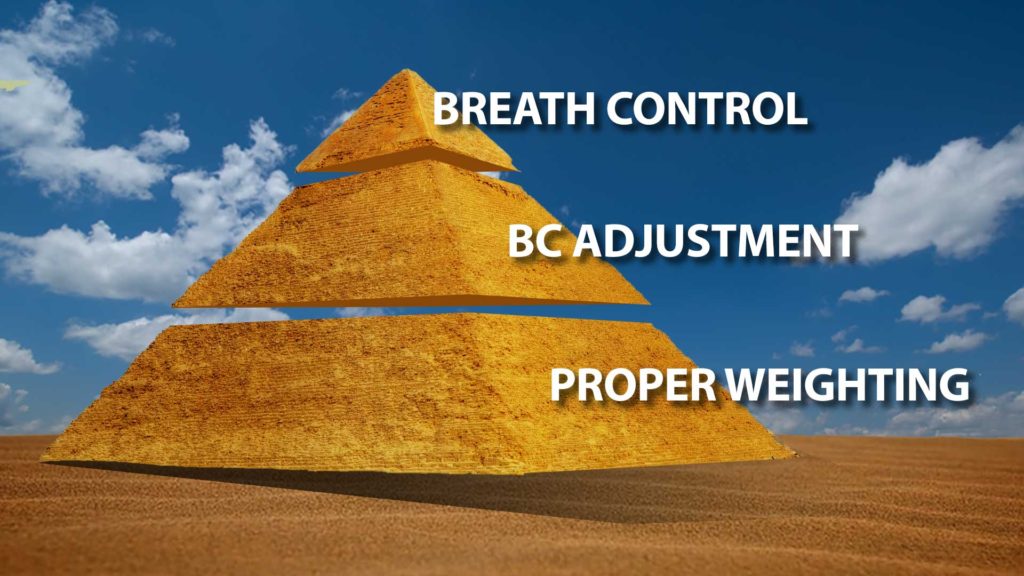Buoyancy control is something that stymies many new divers. And the fault lies not in the diver themselves but rather in how they were taught.
- Too many divers leave their entry-level course with the impression that buoyancy control revolves solely around pushing buttons on a BC. It doesn’t. BC use is an important component of buoyancy control but it is far from being the most important part.
- Too many instructors think that, if their students can do a fin pivot and a Buddha hover, they have somehow “mastered” buoyancy control. They haven’t.
Fin pivots and Buddha hovers are not only unnecessary skills when it comes to teaching buoyancy control, they are actually counterproductive.
- If your fins are touching bottom, as they do in fin pivots, your buoyancy is not under control.
- Similarly, if you can only hover while sitting cross-legged like Buddha, you are not demonstrating good buoyancy control. Body position or trim is an important component of buoyancy control. You are demonstrating good buoyancy control only if you can hover in a horizontal position with your knees in line with your shoulders.
Truly mastering buoyancy control requires understanding the Buoyancy Control Pyramid.
The Buoyancy Control Pyramid
The Buoyancy Control Pyramid is a visual representation of the three critical components of buoyancy control. These are:
- Breath control
- BC adjustment
- Proper weighting
It also shows their relative importance to one another.
Breath control
The term breath control refers to a diver’s ability to make temporary adjustments in buoyancy by changing how deeply he or she breathes. Doing so can result in buoyancy changes of up to five pounds or more.
Bear in mind this does not involve holding your breath. You must still breathe continuously — just a little more deeply or less deeply than normal.
A typical use for breath control would be crossing over something like a shallow ridgeline. Rather than vent your BC as you ascend one side of the ridge, you just breathe a little less deeply. This offsets the temporary expansion of your wetsuit. When on the far side of the ridge, you resume normal breathing.
Also bear in mind that while Breath Control constitutes one-third of the pyramid’s height, it comprises less than ten percent of the pyramid’s volume. Similarly, breath control generally contributes less than ten percent of what it takes to control buoyancy successfully.
BC adjustment
This is the aspect of buoyancy control that “everybody knows.” But it is not the most important aspect.
Underwater, you use your BC to compensate for exposure suit compression and expansion. You add air on descent and vent air on ascent.
How much you need to use your BC is a factor of exposure suit compressibility. Divers wearing relatively thin wetsuits may go through an entire dive without touching their BCs. Similarly, drysuit divers who maintain a constant air volume in their suits throughout the dive will generally not need to touch their BCs underwater.
While BC adjustment constitutes a sizable chunk of the Buoyancy Control Pyramid, this section is still less than half by volume. Similarly, BC adjustment usually comprises less than half of what buoyancy control is all about.
Proper weighting
As the diagram shows, proper weighting is the very foundation of buoyancy control — a fact too many dive instructors fail to teach.
- Divers who strive to wear only the weight that is absolutely necessary will find that maintaining both neutral buoyancy and good body position are almost effortless.
- In contrast, people who dive overweighted will find controlling buoyancy a challenge. They will be constantly yo-yoing up and down, struggling to compensate for the expansion and contraction of extra air in their BCs that is there solely to compensate for the unnecessary weight. They are also at greater risk in an emergency.
While proper weighting comprises only one-third of the Buoyancy Control Pyramid’s height, it constitutes over half the volume. Similarly, proper weighting is more than half of the buoyancy control equation.
© 2020-2021, Sinulogic LLC



